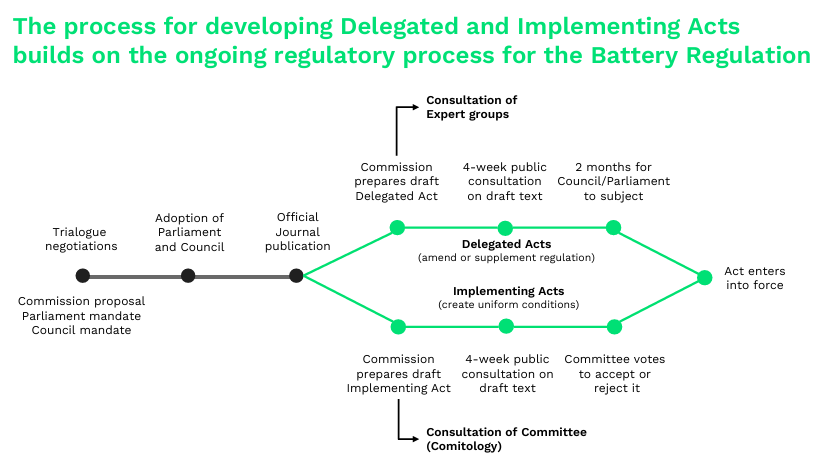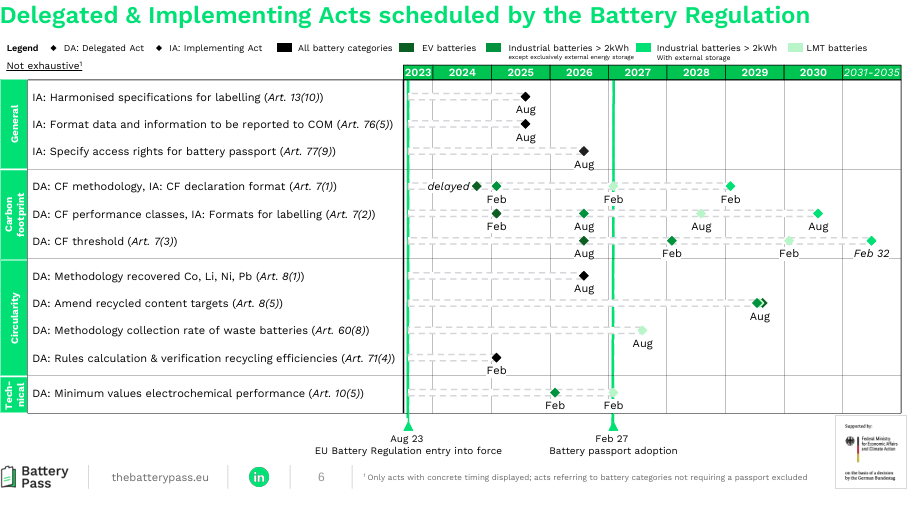2025 EU Battery Regulation Updates Guide
By John Wright
Today, February 18, 2025 we are exactly 6 months away from the planned start of the next phase of the EU Battery Regulation going into effect.
Manufacturers need to get ready or at least have a plan in place. But reading through hundreds of pages of legalese is painful. And that actual start of the regulation going into effect continues to shift. That is why we have a simple primer to all the EU Battery Regulation acts, requirements, and updates that are expected to come up this year.
A quick disclaimer: we’re experts in EU regulation and compliance, but we’re not licensed lawyers. Always get a second opinion.
First, a quick refresher.
What is the EU Battery Regulation?
The EU Battery Regulation is designed to ensure that all batteries in the EU have a low carbon footprint, use as few harmful ingredients as possible, require fewer raw materials from outside the EU, and are reused and recycled within Europe.
The goal is to develop a circular economy, build more secure value chains, and enhance the EU’s autonomy in world affairs.
The regulation covers EV batteries, industrial batteries, and LMT batteries. It requires product carbon footprinting, circularity, performance and durability, reporting, and ultimately the creation of a digital product passport.
For more detailed information, check out our previous blog on the topic.
However, the regulation is only the first step. It provides the legal basis for 32 delegated and 15 implementing acts that are required to put the regulation into force. Delays in these acts result in delays in Battery Regulation compliance coming into force.

Source: Battery Pass
2025 EU Battery Regulation Updates
Three delegated acts and four implementing acts are expected to be passed this year; five in February and two in August.

Source: Battery Pass
February 2025
Article 7(1)
The delegated act on carbon footprint methodology and implementing act on carbon footprint declaration format, which were scheduled for February 18, 2024, have been delayed into this year. Passage is optimistically scheduled for this month.
Article 7(1) content:
For electric vehicle batteries, rechargeable industrial batteries with a capacity greater than 2 kWh and LMT batteries a carbon footprint declaration shall be drawn up for each battery model per manufacturing plant, in accordance with the implementing act and containing, at least, the following information:
- a) Administrative information about the manufacturer;
- b) Information about the battery model;
- c) Information about the geographical location of the battery manufacturing plant;
- d) The carbon footprint of the battery, calculated as kg of carbon dioxide equivalent per one kWh of the total energy provided by the battery over its expected service life;
- e) The carbon footprint of the battery differentiated according to life cycle stage;
- f) The identification number of the EU declaration of conformity of the battery;
- g) A web link giving access to a public version of the study supporting the carbon footprint values referred to in points (d) and (e).
Delegated act and implementing act schedule:
The Commission shall, by 18 February 2024 for electric vehicle batteries, 18 February 2025 for rechargeable industrial batteries, except those with external storage, 18 February 2027 for LMT batteries and 18 February 2029 for industrial batteries with external storage, adopt:
- a) A delegated act in accordance with Article 89 to supplement this Regulation by establishing the methodology for the calculation and verification of the carbon footprint of the battery.
- b) An implementing act establishing the format for the carbon footprint declaration referred to in the first subparagraph.
Schedule of related requirements:
The carbon footprint declaration shall apply from:
- a) February 18, 2025 or 12 months after the date of entry into force either of the delegated act or of the implementing act for electric vehicle batteries;
- b) February 18, 2026 or 18 months after the date of entry into force either of the delegated act or of the implementing act for rechargeable industrial batteries except those with exclusively external storage;
- c) August 18, 2028 or 18 months after the date of entry into force either of the delegated act or of the implementing act, whichever is the latest, for LMT batteries;
- d) August 18, 2030 or 18 months after the date of entry into force either of the delegated act or of the implementing act, whichever is the latest, for rechargeable industrial batteries with external storage.
Article 7(2)
The delegated act on carbon footprint performance classes and implementing act on labeling formats
Article 7(2) content:
Electric vehicle batteries, rechargeable industrial batteries with a capacity greater than 2 kWh and LMT batteries shall bear a conspicuous, clearly legible and indelible label indicating the carbon footprint of the battery and declaring the carbon footprint performance class to which the relevant battery model per manufacturing plant corresponds.
Delegated act and implementing act schedule:
The Commission shall, by 18 February 2025 for electric vehicle batteries, 18 August 2026 for rechargeable industrial batteries except those with exclusively external storage, 18 August 2028 for LMT batteries and 18 August 2030 for rechargeable industrial batteries with external storage, adopt:
- a) A delegated act to supplement this Regulation by establishing the carbon footprint performance classes
- b) An implementing act establishing the formats for the labelling referred to in the first subparagraph and the format for the declaration on the carbon footprint performance class.
Schedule of related requirements:
The carbon footprint performance class requirements in the first subparagraph shall apply from:
- a) 18 August 2026 or 18 months after the date of entry into force either of the delegated act or of the implementing act respectively referred to in the fourth subparagraph, points (a) and (b), whichever is the latest, for electric vehicle batteries;
- b) 18 August 2027 or 18 months after the date of entry into force either of the delegated act or of the implementing act respectively referred to in the fourth subparagraph, points (a) and (b), whichever is the latest, for rechargeable industrial batteries except those with exclusively external storage;
- c) 18 February 2030 or 18 months after the date of entry into force either of the delegated act or of the implementing act respectively referred to in the fourth subparagraph, points (a) and (b), whichever is the latest, for LMT batteries;
- d) 18 February 2032 or 18 months after the date of entry into force either of the delegated act or of the implementing act respectively referred to in the fourth subparagraph, points (a) and (b), whichever is the latest, for rechargeable industrial batteries with external storage.
Article 71(4)
The delegated act on rules calculation and verification of recycling efficiencies
Article 71(4) content:
Each permitted facility shall ensure that all waste batteries made available to that facility are accepted and undergo preparation for re-use, preparation for repurposing or recycling.
Recyclers shall ensure that recycling achieves the targets for recycling efficiency and the targets for recovery of materials.
The rates for recycling efficiency and recovery of materials shall be calculated in accordance with the rules laid down in a delegated act.
Delegated act schedule:
The Commission shall, by 18 February 2025, adopt a delegated act to supplement this Regulation by establishing the methodology for calculation and verification of rates for recycling efficiency and recovery of materials.
Schedule of related requirements:
By 18 August 2026 and at least every five years thereafter, the Commission shall assess whether, due to market developments, in particular concerning battery technologies impacting the type of materials recovered and the existing and forecasted availability of cobalt, copper, lead, lithium or nickel or the lack thereof, and in view of technical and scientific progress, it is appropriate to revise the targets for recycling efficiency and recovery of materials. Where justified and appropriate on the basis of that assessment, the Commission is empowered to adopt a delegated act to amend the targets for recycling efficiency and recovery of materials.
Where appropriate due to market developments impacting the type of materials that can be recovered and in light of technical and scientific progress, including emerging new technologies in waste management, the Commission is empowered to adopt delegated acts by adding further materials with specific targets for recovery of material per specific material.
August 2025
Article 13(10)
The implementing act on harmonized specifications for labelling
Article 13(10) content and implementing act schedule:
The Commission shall, by 18 August 2025, adopt implementing acts to establish harmonised specifications for the labelling requirements referred to in paragraphs 1, 2 and 3 of Article 13 (see below).
Schedule of related requirements:
- From 18 August 2026 or 18 months after the date of entry into force of the implementing act referred to in paragraph 10, whichever is the latest, batteries shall bear a label containing the general information on batteries set out in Part A of Annex VI.
- From 18 August 2026 or 18 months after the date of entry into force of the implementing act referred to in paragraph 10, whichever is the latest, rechargeable portable batteries, LMT batteries and SLI batteries shall bear a label containing information on their capacity.
- From 18 August 2026 or 18 months after the date of entry into force of the implementing act referred to in paragraph 10, whichever is the latest, non-rechargeable portable batteries shall bear a label containing information on their minimum average duration when used in specific applications and a label indicating ‘non-rechargeable’.
Another key part of Article 13 also comes into force in August:
From 18 August 2025, all batteries shall be marked with the symbol for separate collection of batteries (‘separate collection symbol’) as shown in Part B of Annex VI.
The separate collection symbol shall cover at least 3% of the area of the largest side of the battery up to a maximum size of 5 × 5 cm.
In the case of cylindrical battery cells, the separate collection symbol shall cover at least 1.5% of the surface area of the battery and shall have a maximum size of 5 × 5 cm.
Where the size of the battery is such that the separate collection symbol would be smaller than .47 × .47 cm, the battery does not need to be marked with that symbol. Instead, a separate collection symbol measuring at least 1 × 1 cm shall be printed on the packaging.
Article 76(5)
The implementing act on the format of data and information to be reported to COM.
Article 76 content:
Member States shall make publicly available in an aggregated form for each calendar year and in the format established by the Commission in the implementing act, the following data on portable batteries, LMT batteries, SLI batteries, industrial batteries and electric vehicle batteries, according to battery categories and their chemistries:
- a) The amount of batteries made available on the market for the first time in a Member State, including those incorporated in appliances, vehicles or industrial products, but excluding batteries that have left the territory of that Member State in that year, before being sold to end-users;
- b) The amount of waste batteries collected in accordance with Articles 59, 60 and 61, and collection rates calculated on the basis of the methodology set out in Annex XI;
- c) The amount of waste industrial batteries and the amount of waste electric vehicle batteries collected and delivered to permitted facilities for preparation for re-use or preparation for repurposing;
- d) The values for the recycling efficiencies achieved as referred to in Part B of Annex XII and the values for the recovery of materials achieved as referred to in Part C of Annex XII, regarding the batteries collected in that Member State.
Member States shall make those data available within 18 months of the end of the reporting year for which the data are collected. They shall make those data public electronically in the format established by the Commission, using easily accessible data services. The data shall be machine readable, sortable and searchable, and shall respect open standards for third party use. Member States shall notify the Commission when the data referred to in the first subparagraph are made available.
Delegated act and implementing act schedule:
The Commission shall, by 18 August 2025, adopt implementing acts laying down the format for the data and information to be reported to the Commission, as well as assessment methods and operational conditions related to collection and treatment of waste batteries.
Schedule of related requirements:
The first reporting period shall concern the first full calendar year after the entry into force of the implementing act that establishes the format for reporting to the Commission, in accordance with paragraph 5.
How companies should respond to the 2025 EU Battery Regulation updates
Companies that manufacture batteries, sell to battery manufacturers, or are partners in battery supply chains need to stay up to date with the related EU regulations.
With the complex overlaps and links between the EU Battery Regulation and EU law, and the ongoing threat of copycat tariffs and regulation around the world, the easiest way to respond to uncertainty is to start getting compliant.
First, you’ll want to make sure you’re on top of regulation. Make sure that someone, whether a staff member, staff law expert, or third-party counsel, is in charge of keeping you up to date.
Next, you’ll need to get your data pipeline ready for reporting. For example, the Glassdome Product Carbon Footprint platform uses real data from your factory to give you automated analysis showing exactly where you need to pay attention. Plus, our ISO 14067 verification and expert consulting support mean we can provide compliance-ready professional reports as needed. No expensive new sustainability hires necessary. By deploying the IoT hardware and software setup now, you can save yourself a world of pain later.
Finally, start engaging with your supply chain. Accurate product carbon footprints require top-to-bottom supply chain engagement, and getting suppliers on board and data exchanges set up is time consuming.
Just remember, once you’ve got everything set up, your competitors are facing the same struggles. Get ready early, and you’ve got an edge in the global market.
Time to get ready for the EU Battery Regulation
Talk to a Glassdome sustainability compliance expert today


